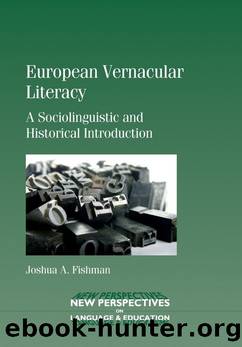European Vernacular Literacy by Joshua A. Fishman

Author:Joshua A. Fishman
Language: eng
Format: epub
ISBN: 978-1-84769-478-2
Publisher: Multilingual Matters
Published: 2011-06-15T00:00:00+00:00
The Role of the Spread of Religion, Philosophy and Style of Life in the Rise of New Languages
The impact of the spread of Religion, which we have already looked at, is not that different from the spread of new technologies more generally, insofar as the birth or death of languages is concerned. It is important, indeed, to realize that both material and subjective factors may move populations to abandon prior beliefs and practices (and the languages through which they are expressed or enacted) in very similar ways. The major difference between these two sets of causal determinants is that religion can more frequently âcut both waysâ, that is, move events toward the rise of a new language (even a totally new language, rather than just one that is territorially and demographically new in certain contexts while it remains fully âat homeâ and fully indigenized elsewhere) as well as moving them toward the demise of an old one. Thus, the rise of Yiddish among Ashkenazim (Jews in or [ancestrally] from Central Europe) in 11th century Alsace-Lorraine, for the purposes of textual translation and commentary among male students, obviously occurred without any immediate impact on the Laâaz or Chuadit that women members of the Worms, Mainz and Schpier communities were already speaking at the time and that they had brought with them from France or Northern Italy (M. Weinreich, 1980 [1973]). However, the continued use of Yiddish led not only to its subsequent displacement of the prior Jewish vernaculars among males, subsequent to their bilingualization, but also to their displacement among females as well in that function (everyday speech), even though the latter long lacked a language of literacy of their own.
The spread of languages into ânewâ areas and populations due to the spread of religions is well known and has had a long and rich history behind it. To begin with, only Latin and Old Church Slavonic were of European provenience, whereas both Hebrew and Arabic were âimportedâ into Europe from the Middle East and/or from North Africa. However, in both respects, that is, whether internally generated or externally forced, the languages of large-scale material change âbehaveâ exactly as disruptively as do the languages that accompany religious spread and religious change. The introduction of the horse into the Americas, the introduction of Christianity, the introduction of the motor, the introduction of capitalism, the introduction of electricity and the introduction of atomic power (for civilian use) have all had similarly dislocative, disruptive and destructive impacts on some languages and have provided greater and more powerful opportunities and advantages for others. The story of the birth and death of languages is part and parcel of the story of social change more generally. It is no more possible to keep vernacular language from changing, constantly and everywhere, than it is to keep sociocultural change from taking place. The rise and fall of languages is merely one aspect of an apparently endless story of an eternally restless species that itself causes most of the changes that engulf it.
Download
This site does not store any files on its server. We only index and link to content provided by other sites. Please contact the content providers to delete copyright contents if any and email us, we'll remove relevant links or contents immediately.
Whiskies (Collins Gem) by dominic roskrow(44280)
Spell It Out by David Crystal(35847)
Cecilia; Or, Memoirs of an Heiress — Volume 1 by Fanny Burney(32063)
Cecilia; Or, Memoirs of an Heiress — Volume 3 by Fanny Burney(31458)
Cecilia; Or, Memoirs of an Heiress — Volume 2 by Fanny Burney(31409)
Beautiful Disaster by McGuire Jamie(25005)
Trainspotting by Irvine Welsh(21027)
Chic & Unique Celebration Cakes by Zoe Clark(19795)
How High Can a Kangaroo Hop? by Jackie French(18673)
Twilight of the Idols With the Antichrist and Ecce Homo by Friedrich Nietzsche(18302)
The Secret History by Donna Tartt(18165)
Cat's cradle by Kurt Vonnegut(14760)
All the Missing Girls by Megan Miranda(14741)
Ready Player One by Cline Ernest(13993)
Fifty Shades Freed by E L James(12916)
Crooked Kingdom: Book 2 (Six of Crows) by Bardugo Leigh(11965)
4 3 2 1: A Novel by Paul Auster(11792)
For the Love of Europe by Rick Steves(11488)
Grundlagen Kreatives Schreiben (German Edition) by Helfferich Pia(10287)
